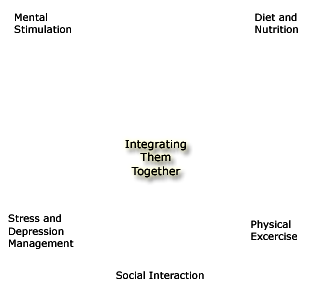Healthy Sweet Alternatives
With Halloween and Thanksgiving on the horizon, and so much information coming out on the harmful effects of refined sugars and most artificial sweeteners, I thought I would share some healthier alternatives to the all too common tricks and treats – which come in the form of hidden refined sugars, and their not so healthy substitutes. Certainly they are a treat for most people, young and old, and certainly we have been tricked into eating too much of it, at the expense of our physical and mental health.
I have talked and written extensively about sugar’s harmful effects and the fact that excessive amounts have been found to increase risk for a host of serious ailments not the least of which are diabetes, atherosclerosis, cancer, kidney disease, loss of vision, loss of brain cells, cerebral shrinkage, and to a major extent Alzheimer’s. According to Authority Nutrition “added sugar is the single worst ingredient in the modern diet.” And as Dr. Shea noted, it’s “like poison” to the brain.
In June I talked about ways to reduce sugar addictions, here I would like to focus on alternatives, since It’s always easier to avoid something if you have some good alternatives.
Recently in a class I was asked if there were any good sugars, or sweeteners, and in another if there were any healthy “ice cream” products.
Fortunately the answers are yes and yes!
There are now lot’s of good alternatives on the market, and I’ve broken them down to those that appear to be better and best. But first some basics.
Sugar Basics
There a are basically three types of sugar, sucrose is a disaccharide (composed of two sugars, glucose and fructose). Glucose is absorbed directly into the blood stream and from there into our cells. Fructose, on the other hand, doesn’t go into the bloodstream like glucose. It has to go to the liver first to be processed. Because it takes longer to be broken down it may not impact insulin resistance so much, but it can also be converted to harmful triglycerides, which may be worse for our vascular system than glucose.
Too much fructose may contribute to unhealthy changes in liver function, triglyceride levels, and insulin sensitivity. Fructose is also harder to digest—especially for people with IBS—than other sugars.
It’s important to keep in mind that too much sugar in the form of sucrose, glucose, or fructose, too fast can lead to a host of problems. The health impact they have on you really depends on the quantities and concentrations. When these are bound to fibers as is commonly the case in fruit and vegetables, they are released at a pace the body can handle. Concentrations of these sugars in candy, milk chocolate, deserts, juices, and especially sodas or diet sodas, or other drinks, however, can overwhelm cells, evoke insulin resistance and advanced glycation end products (AGEs) which are major contributors to aging and age related cognitive decline. .
How Much is Too Much?
Of course it’s hard to set a standard for how much sugar is too much, as every body is different. So unfortunately, there is no simple answer to this question. Some people can eat some added sugar without harm, while others should avoid it as much as possible.
According to the American Heart Association (AHA), the maximum amount of added sugars you should eat in a day are:
Men: 150 calories per day (37.5 grams or 9 teaspoons*).
Women: 100 calories per day (25 grams or 6 teaspoons*).
Go here for more specifics.
Unfortunately they do not list the maximum amount for children, and of course there is a lot of variance in this population, but it would certainly be much less than the amount listed for women.
* Note 1 tsp contains just over 4 g of sugar.
So when you see a 15 oz bottle of “Naked” “no sugar added” fruit or vegetable juice that has 43 g of sugar you know that has the equivalent of more than 10 tsp of sugar! So even though it appears to be a natural healthy smoothie, it is not a “healthy” drink.
The real problem is ingesting large amounts of the wrong kind of sugar. The average American consumes a whopping 22 teaspoons of sugar a day in the form of refined sugar. This wouldn’t be a scary amount if regular table sugar can make people slim and smart. Unfortunately it does just the opposite.
The best source of whole sugar will always be fresh crunchy fruit or berries. Fruits are rich in water, which dilutes the sugar. They are also high in fiber, which slows down the release of fructose in the bloodstream. Fresh fruit is also loaded with nutrients that are essential to health and healing.
Better
The following sweeteners may not be healthy for you in large amounts, but they are better or less damaging in equivalent quantities than refined sugar, high fructose corn syrup, aspartame (Nutrasweet, Equal), or sucralose (Splenda) – all of which have been linked to serious health problems when consumed in high amounts over time.
Organic cane sugar (sucrose, fructose, and glucose with some nutrients) – is unrefined sugar minus the cancer-causing and environmentally damaging pesticides present in conventionally grown sugarcane. Compared to white sugar, organic cane sugar has the full-bodied taste of sugarcane and is much less processed, retaining a lot of the nutrients present in cane juice. Unrefined cane sugar contains 17 amino acids, 11 minerals, and 6 vitamins, plus antioxidants that may help reverse oxidative damage. However, too much of this good thing can still cause problems, especially for any who are insulin resistant or pre-diabetic.
Turbinado sugar (sucrose) – is made from sugar cane but is less refined than table sugar, and so takes longer to breakdown in the body, thus it is less likely to overwhelm the cells and cause insulin resistance.
Coconut sugar (mostly sucrose with some nutrients) – made from the sap of coconut trees is less processed with a more natural brownish color like raw sugar. It can also contain trace amounts of minerals like magnesium, potassium, and inulin, a prebiotic fiber. However, it’s still a high-calorie sweetener and causes AGEs.
Raw honey (fructose & glucose) – Honey’s calling card is that if not over-processed it has anti-microbial and anti-bacterial properties, and some nutrients, which is why it can also be used as a cough suppressant or sore throat soother. Manuka and other high-grade honeys often contain more beneficial properties. However, like sucrose it is quickly broken down in the body, and in high amounts can lead to insulin resistance.
Agave (more fructose than glucose) – generally has a lower glycemic index but this can be misleading. That may be beneficial if someone has diabetes, but not so much if you don’t.
Maple syrup (mostly sucrose with nutrients) – made from the boiled sap of maple trees. Its flavor and color will vary slightly based on the time of season it was harvested and geographic region. Contains small amounts of potassium, calcium, zinc, manganese and magnesium. It also contains antioxidants—up to 54 different types, some of which may have anti-cancer properties, as per one study. But it’s nutrient levels are not as high as most vegetables. Maple syrup’s GI (glycemic index) at 54 is slightly lower than table sugar, or sucrose (65), so it may be less likely to cause quick blood sugar spikes and drops. However, it’s still loaded with concentrated sugar (and easy to over-drizzle), so try measuring out a portion before pouring.
Best
The following are not known to have a detrimental effect on human health. In fact some of these have properties that may promote aspects of human health.
Stevia – Sugar-free and non-caloric, made from the leaves of the stevia plant. If you’re comparing caloric and non-caloric sweeteners, stevia comes out on top. Because stevia is not metabolized (it’s simply excreted), it has no impact on blood sugar—meaning, no spikes and crashes. It doesn’t raise blood sugar and it’s natural and beneficial in reasonable amounts. It’s bio-active, so it could have some anti-inflammatory compounds and can also help cut calories. However, there’s a minor aftertaste that can take getting used to and overusing it could cause you to develop more of a taste for sweets. So even with this, moderation is a wise things to cultivate.
Xylitol, sorbitol, maltitol (sugar alcohols) – The chemical structure of these sugar alcohols gives them the ability to stimulate the sweet taste receptors on your tongue. Although they are generally considered not to have harmful effects in the body, and in fact may have some healthy effects. Xylitol for example, may help to reduce cavities. Too much, however, can cause some digestive issues in some individuals.
Erythritol (sugar alcohol) – This appears to be quite different from the others sugar alcohols. It has a unique chemical structure that our bodies cannot break down and digest. Therefore, it basically passes unchanged through your system and out with your urine. Compared to table sugar which has 4 calories per gram, erythritol has only 0.24 calories per gram. So it is near impossible to consume enough to affect your body weight.And because erythritol is not metabolized by the body’s cells, it does not have any effects on blood sugar or insulin, cholesterol, triglycerides or other biomarkers (7, 8).
So it has almost no calories and none of the harmful metabolic effects of excess sugar. Multiple long-term studies on metabolism and toxicity have found no negative effects of erythritol consumption, at least not in test animals.
Truvia – Is not a natural sugar, because it is made almost entirely of erythritol. So even though it is often advertised as a “natural sweetener” it is not. However, for those who are overweight, diabetic or have issues related to metabolic syndrome, Truvia (or plain erythritol) is a good alternative to sugar.
Munk fruit – is advertised as the only zero calorie, zero glycemic sweetener that cooks and bakes like sugar. It is not yet as available as some sweeteners but appears to be much better than most.
Date sugar – This retains some nutrients from whole dates such as small amounts of fiber, calcium, potassium, and magnesium. It contains fewer calories than table sugar, and while its GI is unknown, it’s likely close to that of whole dates and lower than table sugar (39 to 65). However, it doesn’t dissolve in drinks, so it’s best sprinkled on foods
Ice cream
Unfortunately one of our most beloved treats, shown to have an adverse impact on health when consumed in excess, is ice cream. Of course that’s because it’s generally loaded with sugar, There are now healthier alternatives however. Here are a few links to learn more.
The Best Ice Cream and Frozen Treats for People Who Care About Health
http://greatist.com/eat/best-ice-cream-frozen-desserts
http://www.eatenlightened.com/?gclid=CKmYtIrt1s8CFRCbfgodQGwH1g
http://www.halotop.com/us-vs-them/?gclid=CMaOtvnu1s8CFQ90fgodxwMDBg uses stevia
Halloween can be a fun time for children and adults. But eating too much of the wrong kinds of sugar, can get scary. Fortunately our population is becoming more aware of these dangers and finally manufacturers are providing more, and better alternatives. But it’s still buyer beware time. Check the labels, stick with whole fruit and veggies whenever possible. Use sweeteners sparingly. Be wise and eat healthy this holiday season. That seems to be the best way to go.
Prevention Strategies 








- FREE SPECIAL REPORT AND UPDATES
For free monthly updates on the latest practical research related to brain health and memory improvement, and a free 23 page report on How to Prevent or Arrest Alzheimer's, Click here. Recent Comments
Archives
- July 2019
- November 2018
- September 2018
- July 2018
- June 2018
- April 2018
- February 2018
- January 2018
- December 2017
- October 2017
- September 2017
- August 2017
- June 2017
- May 2017
- March 2017
- January 2017
- December 2016
- October 2016
- September 2016
- August 2016
- June 2016
- May 2016
- April 2016
- March 2016
- February 2016
- January 2016
- December 2015
- November 2015
- August 2015
- July 2015
- June 2015
- May 2015
- April 2015
- March 2015
- February 2015
- January 2015
- November 2014
- October 2014
- September 2014
- August 2014
- July 2014
- June 2014
- April 2014
- March 2014
- February 2014
- January 2014
- December 2013
- November 2013
- October 2013
- September 2013
- August 2013
- July 2013
- June 2013
- June 2012
- February 2012
- January 2012





